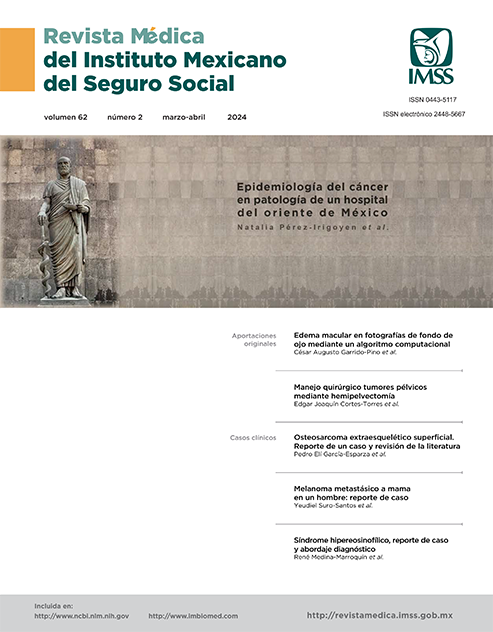Incidence of advanced chronic disease, need for palliative care and in-hospital mortality
Main Article Content
Keywords
Mortality, Prognosis, Chronic Disease, Palliative Care
Abstract
Background: There is a continuing increase in the prevalence of people affected with progressive chronic diseases. Palliative care is another form of care and organization of health problems that improve quality.
Objective: To determine the incidence of patients with advanced chronic illness and need of palliative care (NPC) and intrahospital mortality in a reference hospital.
Methods: Prospective observational study in hospitalized patients over 18 years of age in the internal medicine department who met at least one criterion of the NECPAL CCOMS-ICO tool. They were followed until death or discharge to determine intrahospital mortality. We used descriptive and inferential statistics.
Results: We studied 370 admissions from April to August 2021, including 110 patients, 59 women (55.3%) and 51 men (44.7%), age 65.5 ± 15.85 years. The incidence of NPC was 29.7%. The most frequent comorbidity was oncologic in 39 patients (35.5%), followed by chronic heart disease in 17 patients (15.5%); 38 patients were classified as NECPAL grade I (34.5%), 44 NECPAL II (40%) and 28 NECPAL III (25.5%). Twenty-five patients died during their in-hospital stay, with a mortality of 22.7%.
Conclusions: The incidence of hospitalized patients in need of palliative care is considerable, more than half of them for non-oncologic pathology. More effective care strategies are required for external referral and multidisciplinary in-hospital care.
References
Serra-Valdés M, Serra-Ruíz M, Viera-García M. Las enfermedades crónicas no transmisibles: magnitud actual y tendencias futuras. Revista Finlay. 2018;8(2):140-8. Disponible en: http://scielo.sld.cu/scielo.php?script=sci_arttext&pid=S2221-24342018000200008&lng=es.
Milazzo S, Hansen E, Carozza D, et al. How Effective Is Palliative Care in Improving Patient Outcomes? Curr Treat Options Oncol. 2020;21(2):12. doi: 10.1007/s11864-020-0702-x.
Gómez-Batiste X, Martínez-Muñoz M, Blay C, et al. Identifying needs and improving palliative care of chronically ill patients: a community-oriented, population-based, public-health approach. Curr Opin Support Palliat Care. 2012;6(3):371-8. doi: 10.1097/SPC.0b013e328356aaed.
Organización Mundial de la Salud. Cuidados paliativos. Disponible en: https://www.who.int/es/news-room/fact-sheets/detail/palliative-care#:~:text=Datos%20y%20cifras%201%20Los%20cuidados%20paliativos%20mejoran,de%20ingreso%20bajo%20e%20ingreso%20mediano.%20M%C3%A1s%20elementos
Cotogni P, Saini A, De Luca A. In-Hospital Palliative Care: Should We Need to Reconsider What Role Hospitals Should Have in Patients with End-Stage Disease or Advanced Cancer? J Clin Med. 2018;7(2):18. doi: 10.3390/jcm7020018.
Highet G, Crawford D, Murray SA, et al. Development and evaluation of the Supportive and Palliative Care Indicators Tool (SPICT): a mixed-methods study. BMJ Support Palliat Care. 2014;4(3):285-90. doi: 10.1136/bmjspcare-2013-000488.
Calsina-Berna A, Amblàs Novellas J, González-Barboteo J, et al. Prevalence and clinical characteristics of patients with Advanced Chronic Illness and Palliative Care needs, identified with the NECPAL CCOMS-ICO© Tool at a Tertiary Care Hospital. BMC Palliat Care. 2022;21(1):210. doi: 10.1186/s12904-022-01101-4.
Gómez-Batiste X, Martínez-Muñoz M, Blay C, et al. Identifying patients with chronic conditions in need of palliative care in the general population: development of the NECPAL tool and preliminary prevalence rates in Catalonia. BMJ Support Palliat Care. 2013;3(3):300-8. doi: 10.1136/bmjspcare-2012-000211.
Gómez-Batiste X, Amblás J, Costa X, et al. Recomendaciones para la atención integral e integrada de personas con enfermedades o condiciones crónicas avanzadas y pronóstico de vida limitado en Servicios de Salud y Sociales: NECPAL-CCOMS-ICO© 3.1. [Internet] (Actualizado 2017, citado 2023 Mayo 10). Disponible en: http://mon.uvic.cat/catedra-atencion-cuidados-paliativos/
Radbruch L, De Lima L, Knaul F, et al. Redefining Palliative Care-A New Consensus-Based Definition. J Pain Symptom Manage. 2020;60(4):754-764. doi: 10.1016/j.jpainsymman.2020.04.027.
Gómez-Batiste X, Martínez-Muñoz M, Blay C, et al. Utility of the NECPAL CCOMS-ICO© tool and the Surprise Question as screening tools for early palliative care and to predict mortality in patients with advanced chronic conditions: A cohort study. Palliat Med. 2017;31(8):754-763. doi: 10.1177/0269216316676647.
Gómez-Batiste X, Martínez-Muñoz M, Blay C, et al. Identificación de personas con enfermedades crónicas avanzadas y necesidad de atención paliativa en servicios sanitarios y sociales: elaboración del instrumento NECPAL CCOMS-ICO©. Med Clin (Barc). 2013;140(6):241-245. doi: 10.1016/j.medcli.2012.06.027.
Calsina-Berna A, Martinez-Muñoz M, Bardés Robles I, et al. Intrahospital Mortality and Survival of Patients with Advanced Chronic Illnesses in a Tertiary Hospital Identified with the NECPAL CCOMS-ICO© Tool. J Palliat Med. 2018;21(5):665-673. doi: 10.1089/jpm.2017.0339.
Szekendi MK, Vaughn J, Lal A, et al. The Prevalence of Inpatients at 33 U.S. Hospitals Appropriate for and Receiving Referral to Palliative Care. J Palliat Med. 2016;19(4):360-372. doi: 10.1089/jpm.2015.0236.
Köstenberger M, Neuwersch S, Weixler D, et al. Prevalence of palliative care patients in emergency departments. Wien Klin Wochenschr. 2019;131(17-18):404-409. doi: 10.1007/s00508-019-1530-5.
Maas EAT, Murray SA, Engels Y, et al. What tools are available to identify patients with palliative care needs in primary care: a systematic literature review and survey of European practice. BMJ Support Palliat Care. 2013;3(4):444-51. doi: 10.1136/bmjspcare-2013-000527.
Cohen-Mansfield J, Skornick-Bouchbinder M, Brill S. Trajectories of End of Life: A Systematic Review. Journals of Gerontology - Series B Psychological Sciences and Social Sciences. 2018;73(4):564-72.
ElMokhallalati Y, Bradley SH, Chapman E, et al. Identification of patients with potential palliative care needs: A systematic review of screening tools in primary care. Palliat Med. 2020;34(8):989-1005. doi: 10.1177/0269216320929552.
Trujillo-De Los Santos Z, Paz-Rodríguez F, Corona T, et al. Research on Palliative Care in Mexico. Scoping review. Rev Mex Neuroci. 2018;19(2):74-85.
Zuckerman RB, Stearns SC, Sheingold SH. Hospice Use, Hospitalization, and Medicare Spending at the End of Life. J Gerontol B Psychol Sci Soc Sci. 2016;71(3):569-80. doi: 10.1093/geronb/gbv109.
Zamora-Mur A, Nabal-Vicuña M, Zamora-Catevilla A, et al. Declive funcional y presencia de síntomas en cuidados paliativos: ¿causa o consecuencia? Rev Esp Geriatr Gerontol. 2017;52(3):142-145. doi: 10.1016/j.regg.2016.10.004.
Moretti D, Buncuga MG, Laudanno CD, et al. Índice PROFUND y mortalidad intrahospitalaria. Índice PROFUND y mortalidad intrahospitalaria en pacientes pluripatológicos. Análisis post-hoc. Medicina. 2021;81(3):329-336. Disponible en: http://www.scielo.org.ar/scielo.php?script=sci_arttext&pid=S0025768020210003 0329&lng=es.
Cortés-Sierra D, Forero-Durán NJ, Sarmiento-Reyes ÉM, et al. Mortalidad en pacientes hospitalizados en el servicio de medicina interna de un hospital universitario. Acta Medica Colomb. 2019;44(1):11-16.
Milnes S, Orford NR, Berkeley L, et al. A prospective observational study of prevalence and outcomes of patients with Gold Standard Framework criteria in a tertiary regional Australian Hospital. BMJ Support Palliat Care 2019;9(1):92-9. doi: 10.1136/bmjspcare-2015-000864.
Tuca-Rodriguez A, Gómez-Batiste X, Espinosa-Rojas J, et al. Structure, organisation and clinical outcomes in cancer patients of hospital support teams in Spain. BMJ Support Palliat Care. 2012;2(4):356-62. doi: 10.1136/bmjspcare-2011-000083.


